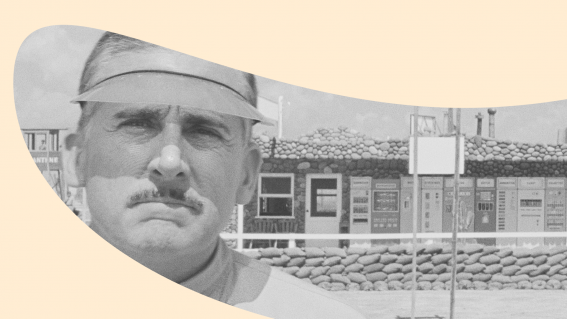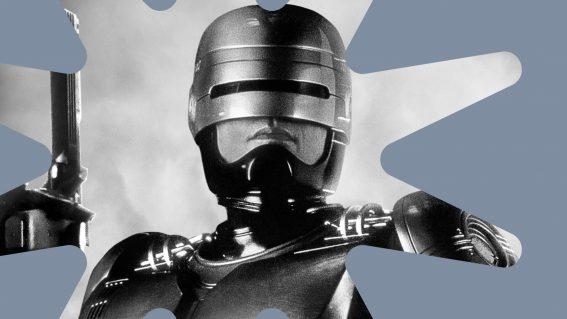Looper: Explained (With Straws)
I love Looper. It took me a second viewing to confidently draw that conclusion, but I truly heart Rian Johnson’s action sci-fi beast. If I had the time, the smarts and the cups of coffee, I would write an entire thesis on the film. But my time is short, my smarts are limited and my […]

I love Looper. It took me a second viewing to confidently draw that conclusion, but I truly heart Rian Johnson’s action sci-fi beast. If I had the time, the smarts and the cups of coffee, I would write an entire thesis on the film. But my time is short, my smarts are limited and my cups of coffee are one. Instead, I want to try and explain the particular science behind Looper’s time travel mechanics.
Part of what I admire about Looper is how it sets its own rules for time travel. It bypasses any bloated exposition by simply allowing you to witness how the world’s mechanics work. It knows it doesn’t adhere to any conventional understandings of time travel, but it never breaks its own unique parameters either (as vague as they might be). This leads to a wealthy number of stupendously rad moments that I will explore in spoilerific detail. So if you haven’t seen it yet, leave your computer (right now), go out to a cinema, watch it, hi-five somebody and come back to this article.
A while back, I did a little exploration into the mechanics of movie time travel, lifting from four popular scientific theories. Have a quick blaze through it if you haven’t read it, but I’ll give you the cliff notes for your reference.
THE THEORIES
Theory A – Fate: there is only ever one destined timeline in the entire universe. If you travel to the past, your actions will not change the timeline at all, for they were always meant to happen (e.g. Timecrimes).
Theory B – Alternate Universes: Travelling to the past causes the creation of an alternate universe/timeline (e.g. Star Trek).
Theory C – Success: Instead of creating another universe/timeline, it shifts the current one, for there is only one linear universe/timeline in this theory. Thus, the previous future ceases to exist (or be altered). This could lead to the non-existence of the person that travelled (e.g. Back to the Future).
Theory D – Observer Effect: Just like Success except the traveller is essentially ‘Out of time,’ meaning they will not be affected by change (e.g. Groundhog Day).
THE ELEMENTS
Let’s tackle the rules and qualities of Looper’s time travel science implied by the film. The first is hinted at in two scenes: Gordon-Levitt being told by Jeff Daniels that “this time travel stuff will fry your brain” and Bruce Willis essentially telling him “this shit is complicated.” So here’s the first element:
This shit is complicated.
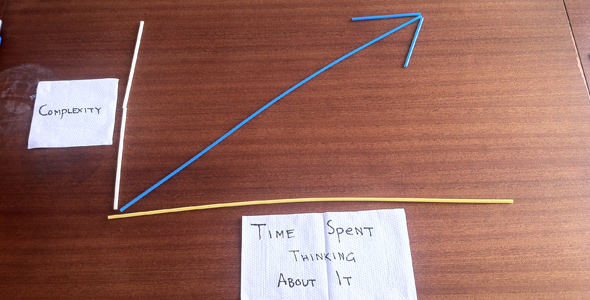
Yeah, that’s not a particularly hard quality to nail down, I know. However, it’s important for Looper to explicitly state this, for not only is it saying that this particular time travel theory is vast and deep, but that you also don’t need a masters in astrophysics to understand how it works in context to the movie. By overtly showing a reluctance to explain its mechanic, it makes its audience feel safe in not needing to know those mechanics either. That’ll be left for nerds like me to unpack.
This shit is still complicated however, so you can rule out any simple time travel mechanic you think they may be utilising. Looper doesn’t strictly pick one of the four theories I highlighted; it smashes two of them together: Alternate Universes and Success. I’ll go into this a little later.
The next element is shown with the dismantling death of older Seth early in the film. When young Seth lets his loop run, he is captured and surgically torn apart piece by piece, causing the older Seth to lose the same body parts at the same time. Thus:
Any permanent physical change that happens to the past version will instantly affect the future version in the same time.
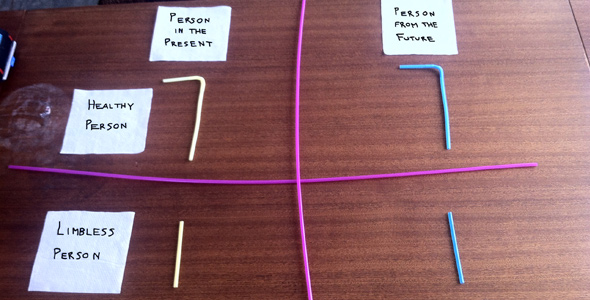
Therefore, a traveller can be affected by actions of the past. This means we can rule out The Observer Effect entirely, and it also backs up the Success theory.
“But wait! Wouldn’t such an extreme change have a resounding impact on the future!? Wouldn’t losing most of his body prevent Seth from ever going back to the past?”
Calm down, spaz; I’ll deal with that question a little later, but onto the next quality of Looper’s time travel science.
This one goes hand-in-hand with the previous element, and is pretty vital to the plot. When Joe (Willis) first knocks himself (Go-Levs) the f*ck out in the cornfield, he tracks his younger self later that night. Old Joe does this by “remembering” what young Joe does as he does it. This memory mechanic is explained further in the diner where the two Joes meet. Here’s the element:
When a contradicting event looks more likely to happen for the past version, the contradicted memory from the future version’s mind becomes fuzzier.
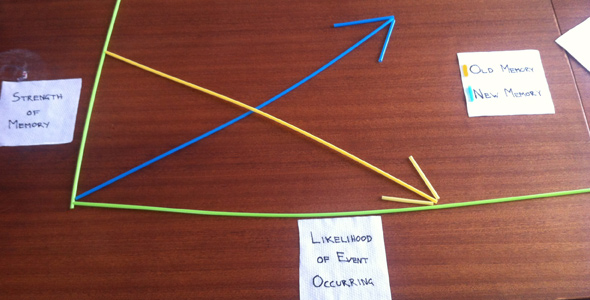
This memory mechanic is demonstrated most prominently when Go-Levs is slapped awake by Sara (Emily Blunt). This is the very first moment young Joe gets a good look at her face. Later on, they have some hot impulsive sex. It’s a far stretch to say they’re in love. Blunt just wanted to bang and it’s not like Go-Levs was gonna say no. However, this sparks the potential for them to be in love.
This potential decreases the possibility of Willis ever having met his Chinese wife. Thus, the first moment Go-Levs sees Sara’s face causes Willis’s memory of the first time he saw his wife to fade. However, Willis is able to retain the fuzzy memory, for Sara and Go-Levs’ relationship hasn’t developed into anything significant (but the potential is there).
The idea of ‘potential events’ is a vital clue to understanding the time travel mechanics in Looper.
THE SCIENCE
I mentioned before that Looper creates its own time travel theory by merging two conventional ones: Alternate Dimensions and Success. This means the following:
1) Travelling back to the past can alter the future, creating another dimension in the process.
2) Changing past events can affect the traveller (e.g. losing limbs).
The initial problem people have with this theory-merger is the seemingly contradictory nature of those two propositions. If a traveller creates/goes to an alternate dimension, are they not immune to any consequences faced by their younger, alternate self? How can an altered dimension still affect the original dimension the traveller came from?
I’ll explain it through some diagrams in order to prevent an egg fu yung of the brain. Here’s a conventional look at the Alternate Dimensions theory of time travel:
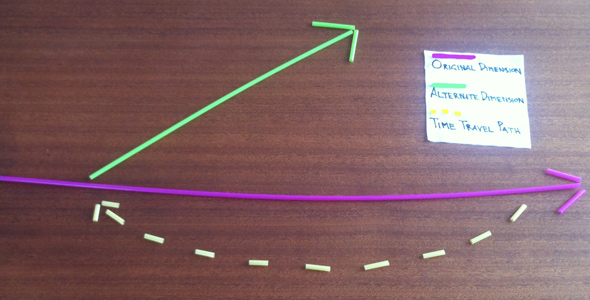
Here, we can see the alternate dimension straying away from the original dimension the traveller came from. This alternate dimension does not cross or affect the original dimension. Thus, the traveller will not be personally affected by any consequences experienced by their younger, alternate self. However, Looper is not this stringent.
Instead, the two dimensions can be manipulated while remaining conjoined in a certain way. The more manipulation that takes place, the less likely it is for the traveller to be able to go through time. But as long as there is a possibility of that person still being able to travel through time, the effects on the younger version will still take place. It kinda sorta looks like this:
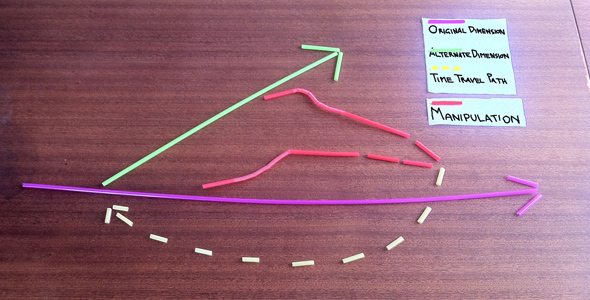
The temporal nature of Looper’s world wants the alternate dimension to remain as true to the original dimension as possible in order to avoid unnatural paradoxes. However, if a paradox were to occur, it’s not going to mean the entire universe implodes* (as the ending proves). It simply means that it’s unnatural for paradoxes to occur in the universe.
*Jeff Daniels makes an implication that no paradox in history (oxymoron?) has ever been recorded by stating that killing the present Seth while future Seth was running around could be “catastrophic.” This gives the impression that they have no idea how a paradox affects the time-space continuum, adding an even greater risk to Go-Levs’ fatal endgame decision.
It’s similar to how opposite poles from two different magnets attract each other. They do not want to separate; it’s natural. An attraction is still held between them even when they are being forced apart (just like the original and alternate dimensions). However, with enough force, the attraction will cease and the magnets will separate.
This is by no means a precise science (as they quite clearly state in the film). But Looper remains consistent to the rules of its universe. With those parameters in clear view, we can now frame the entire plot dimension by dimension. Take a deep breath, ‘cause shit’s about to get serious.
THE PLOT
We are presented with three key dimensions in Looper. Here’s the diagram:
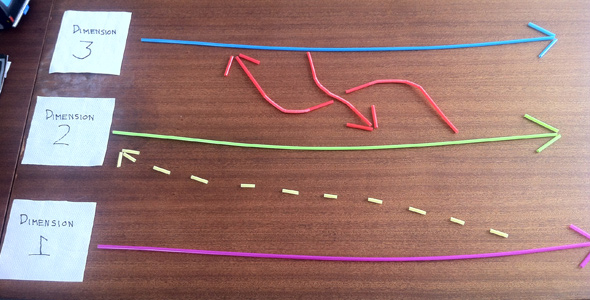
Dimension 1 is implied. This is the one belonging to the Joe who received a chest full of younger Joe’s blunderbuss (the moment before the start of the awesome 30 year montage). What happened in this older Joe’s past that didn’t cause him to fight back? We can’t be entirely sure, but it’s safe to assume that the incident with his Chinese wife never happened in this dimension. Hell, this Joe might not’ve ever met her for all we know. But we do know this: the dimension that dead Joe travelled to (Dimension 2) differs from the dimension he previously belonged in (Dimension 1). But what caused this change?
Well, technically any time traveller could’ve altered Dimension 2, but I’m convinced it was Jeff Daniels who triggered the change. He said to young Joe (before the loop closed) that he’s from the future, and that Joe should go to China instead of France. Did Jeff Daniels say this to the Joe from Dimension 1? It’s possible that he didn’t. Jeff Daniels could even be from Dimension 1 and travelled back in time to Dimension 2 at some earlier date, triggering the change.
This off-hand remark doesn’t seem that impactful at the time, but going to China causes Joe to fall in love. If anything is powerful enough to split the universe, it’s the power of love (*gag*). In Dimension 1, Joe may have stuck to his original plan, travelling to France instead. 30 years later, he is captured and sent back in time to his death.
Compare this to the latter part of Dimension 2. Bruce Willis is taken in by The Rainmaker’s men (looking like the black Spanish inquisition, as no one would suspect). There, he witnesses the death of his beloved wife at the hand of some douche with an itchy trigger finger. He’s taken to some pod-like rusted hunk-of-crap that’s apparently a time machine. He then delivers his captives a seismic beat down, enters the pod and travels back in time to Dimension 3 to stop The Rainmaker from ever existing, saving his wife in theory.
Dimension 3 is the meat of the movie. Joe Gordon-Levitt is trying to hunt down Joe Willis (i.e. trying to close his loop), where he runs into Sara and her son Sid (the future Rainmaker) and a whole bunch of cool shit happens that I don’t really need to detail. However, the ending is crucial, for it presents a choice.
Young Joe sees his older self about to put a bullet in Sara, causing Sid to travel the path of The Dark Side and become The Rainmaker. With the existence of The Rainmaker, Joe Willis’ potential wife (the one the universe will try to direct him towards) will likely be killed in the same fashion, causing him to travel back in time to kill Sid again. This is the loop young Joe foresaw, as shown by the red straws (notice that it also makes an infinity symbol).
This does not mean that the exact same events will happen in the exact same way. Rather, key events will remain fixated due to the universe’s “magnetic” desire to keep dimensions linear.
So, young Joe has two options: save himself and keep the loop going or sacrifice himself and use the paradox to break the cycle. He chose to change the time-space continuum by shooting himself into a paradox. This is what makes Joe a total mother f*cking badass.
Of course, he could’ve just shot his hand instead…














